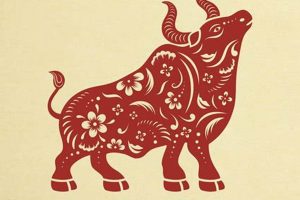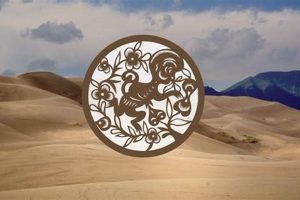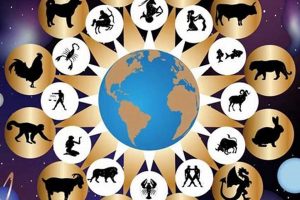Within the 12-year cycle of the Chinese zodiac, individuals born during specific years are said to be born under the influence of the Ox. These years recur every 12 years. Those born under this sign are often characterized as diligent, dependable, strong, and determined. For example, individuals born in 1961, 1973, 1985, 1997, 2009, and 2021 are all considered Oxen.
This system of symbolic animals and their associated attributes plays a significant role in Chinese culture, influencing various aspects of life from personality interpretations to compatibility predictions and even auspicious dates for important events. Its historical roots lie in ancient agrarian society, with the animals chosen representing different aspects of the agricultural cycle and its connection to the natural world. Understanding the characteristics associated with each animal sign provides a framework for navigating interpersonal relationships and making life choices.
Further exploration of this topic will delve into specific personality traits, compatible signs, career prospects, and predictions for individuals born under the influence of this particular zodiac animal. This includes examining the nuances associated with the five elements wood, fire, earth, metal, and water which further refine the characteristics of each sign within the 12-year cycle.
Tips for Those Born Under the Ox Sign
Individuals born under the influence of the Ox can benefit from understanding their strengths and weaknesses. These tips offer guidance for navigating various life aspects based on common characteristics associated with this sign.
Tip 1: Embrace Patience: Cultivating patience can assist Oxen in overcoming challenges and achieving long-term goals. Major projects may require sustained effort and attention to detail, and resisting impulsive actions can lead to greater success.
Tip 2: Value Reliability: Known for their dependability, Oxen should leverage this strength in building strong relationships and career advancement. Maintaining consistency in actions and communication fosters trust and respect.
Tip 3: Practice Flexibility: While steadfastness is a virtue, learning to adapt to changing circumstances can prevent stagnation. Embracing new ideas and approaches can broaden perspectives and lead to personal growth.
Tip 4: Cultivate Open Communication: Oxen sometimes struggle with expressing emotions. Practicing open and honest communication can strengthen relationships and prevent misunderstandings.
Tip 5: Seek Balance: Hard work is essential, but neglecting personal well-being can lead to burnout. Prioritizing self-care, including rest and relaxation, is crucial for maintaining long-term health and productivity.
Tip 6: Develop Emotional Intelligence: Understanding and managing emotions, both one’s own and others’, can greatly enhance interpersonal skills and facilitate smoother interactions.
By understanding these key characteristics and applying these tips, individuals born under the influence of the Ox can enhance their strengths and navigate life’s challenges more effectively. These insights provide a foundation for personal growth and achieving greater fulfillment.
These tips offer valuable insights into leveraging the strengths associated with this particular zodiac sign. Further exploration might include personalized readings and consultations with astrology experts for a deeper understanding of individual nuances.
1. Personality Traits
Individuals born during Ox years are often associated with specific personality traits rooted in Chinese astrological tradition. These traits, while not deterministic, offer a framework for understanding behavioral tendencies and potential strengths and weaknesses.
- Diligence and Determination
Oxen are known for their strong work ethic and unwavering focus on goals. They demonstrate persistence in overcoming obstacles and are not easily discouraged. This dedication often leads to significant accomplishments in their chosen endeavors, whether professional or personal. For example, an Ox might meticulously work through a complex project, step-by-step, until its successful completion, even when faced with setbacks.
- Honesty and Integrity
Strong moral principles and a commitment to truthfulness are hallmarks of the Ox personality. They value straightforward communication and tend to be forthright in their interactions. This integrity often earns them respect and trust in their relationships and professional life. An Ox, for instance, is unlikely to compromise their values for personal gain.
- Patience and Reliability
Oxen are often seen as dependable and patient individuals. They approach situations with a calm and steady demeanor, offering stability and support to those around them. This reliability makes them valuable friends, colleagues, and partners. They are the type of people who will consistently show up and offer support, even in challenging times.
- Caution and Conservatism
While their steadfast nature is a strength, Oxen can sometimes exhibit cautiousness and a preference for traditional approaches. They may be hesitant to embrace change and prefer familiar routines. While this groundedness provides stability, it can also lead to missed opportunities if not balanced with a willingness to adapt. For example, an Ox might be resistant to adopting new technologies or unconventional methods.
Understanding these core personality traits provides valuable insight into the strengths and potential challenges associated with individuals born under the Ox sign. While these characteristics are not absolute predictors of behavior, they offer a lens through which to interpret actions and motivations, fostering greater understanding and facilitating more effective interactions.
2. Elemental Variations
The Chinese zodiac incorporates five elements Wood, Fire, Earth, Metal, and Water which interact with the twelve animal signs to create a 60-year cycle. Each element imbues the Ox with distinct characteristics, further refining the general personality traits associated with the sign. This elemental influence provides a more nuanced understanding of individual Oxen, acknowledging variations within the broader zodiac archetype. For example, a Wood Ox might exhibit greater flexibility and adaptability compared to a Metal Ox, who may be more rigid and uncompromising. Understanding these elemental nuances offers deeper insights into individual personalities and potential behaviors.
The Wood Ox (e.g., 1985) is often characterized by creativity and a strong sense of morality. The Fire Ox (e.g., 1937, 1997) tends to be more ambitious and driven, possessing strong leadership qualities. The Earth Ox (e.g., 1949, 2009) typically embodies practicality, stability, and a methodical approach. The Metal Ox (e.g., 1961) is often characterized by strength, resilience, and a focus on achieving tangible results. Finally, the Water Ox (e.g., 1973) often demonstrates strong interpersonal skills, adaptability, and an ability to navigate complex situations with grace. These variations demonstrate the interplay between the fixed characteristics of the Ox and the modulating influence of the five elements.
Recognizing the specific elemental influence within an individual’s birth year provides a more comprehensive understanding of their potential strengths, weaknesses, and behavioral tendencies. This nuanced perspective can facilitate more effective communication and deeper interpersonal understanding. While the core Ox traits of diligence, dependability, and strength remain constant, the elemental overlay adds layers of complexity and individuality. This framework highlights the importance of considering both the animal sign and the associated element for a truly insightful astrological interpretation.
3. Compatibility
Compatibility in Chinese astrology plays a crucial role in assessing the potential harmony between individuals, particularly in romantic relationships, friendships, and business partnerships. For those born under the Ox sign, understanding compatibility with other signs can provide valuable insights into the dynamics of these relationships. This system is based on the interactions between the twelve animal signs and their inherent characteristics. Certain signs are considered more compatible, fostering smoother interactions and mutual understanding, while others may present more challenges due to conflicting personality traits or approaches to life. For example, the Ox is generally considered highly compatible with the Rat, Snake, and Rooster, while pairings with the Sheep or Horse might require more effort to navigate potential differences.
The Ox’s grounded and dependable nature often seeks stability and reliability in relationships. They are drawn to individuals who share similar values and demonstrate commitment. Conversely, signs known for impulsivity or a lack of practicality might create friction in a relationship with an Ox. Consider a business partnership between an Ox and a Tiger. The Ox’s methodical approach might clash with the Tiger’s more impulsive and risk-taking nature. However, if both individuals recognize and respect these differences, they can leverage their complementary strengths to achieve mutual success. An Ox paired with a Rat, on the other hand, might find a harmonious balance due to the Rat’s shrewdness and the Ox’s steadfastness, creating a strong foundation for a successful enterprise.
Understanding compatibility within the context of Chinese astrology provides a framework for navigating interpersonal dynamics. While not a definitive predictor of relationship success, it offers valuable insights into potential strengths and challenges. This knowledge allows individuals to approach relationships with greater awareness and adapt their communication styles to foster harmony and mutual understanding. Recognizing potential areas of conflict allows for proactive strategies to mitigate challenges and build stronger, more fulfilling relationships, whether romantic, platonic, or professional. Further exploration of individual birth charts and elemental influences can offer even deeper insights into relationship dynamics.
4. Career & Finances
Career and financial prospects for those born under the Ox sign are often influenced by the inherent characteristics associated with this zodiac animal. Their diligent nature, strong work ethic, and commitment to stability often translate into specific career paths and financial management styles. Understanding these tendencies can provide valuable insights for individuals seeking to align their professional pursuits and financial strategies with their innate strengths.
- Suitable Career Paths
Oxen often thrive in careers that require dedication, patience, and attention to detail. Fields such as engineering, architecture, medicine, law, and finance often align well with their methodical approach and commitment to long-term goals. Their reliability and strong sense of responsibility make them valuable assets in leadership roles, though they may prefer to lead by example rather than through charismatic pronouncements. For example, an Ox might excel as a project manager, steadily guiding a team to successful completion through meticulous planning and consistent effort.
- Financial Management
Oxen typically approach finances with a conservative and practical mindset. They prioritize stability and long-term security, often preferring to save and invest wisely rather than engaging in speculative ventures. They value tangible assets and are generally cautious about taking on unnecessary debt. This pragmatic approach often leads to financial stability and allows them to weather economic fluctuations with greater resilience. An Ox might prioritize paying off a mortgage quickly or consistently contribute to retirement savings, demonstrating their focus on long-term financial security.
- Challenges and Opportunities
While the Ox’s steadfastness is a strength, it can also present challenges in adapting to rapidly changing environments. They may need to consciously cultivate flexibility and embrace new approaches to remain competitive in dynamic industries. Opportunities for growth often arise when Oxen leverage their natural leadership abilities and combine their methodical approach with innovative thinking. For example, an Ox in a technology field might need to actively pursue continuous learning to stay abreast of new advancements and adapt their skills accordingly.
- Work-Life Balance
Oxen’s dedication to their work can sometimes lead to an imbalance between professional and personal life. It’s crucial for them to prioritize self-care and set boundaries to prevent burnout. Cultivating hobbies, spending time with loved ones, and engaging in activities that promote relaxation are essential for maintaining long-term well-being and maximizing their overall productivity. An Ox might benefit from scheduling regular downtime, just as they would schedule important work tasks, to ensure they maintain a healthy work-life balance.
Understanding the interplay between these facets and the inherent characteristics of the Ox provides valuable guidance for individuals navigating their career and financial journeys. By leveraging their strengths and addressing potential challenges, Oxen can create fulfilling careers and achieve long-term financial security. This understanding empowers them to make informed decisions aligned with their values and aspirations, ultimately leading to greater professional and personal fulfillment.
5. Historical Context
Understanding the historical context of the Year of the Ox within Chinese astrology provides a deeper appreciation for its significance and enduring influence. Rooted in ancient agrarian society, the Ox’s symbolism reflects its practical value and contribution to agricultural life. Examining this historical context illuminates the cultural values and beliefs associated with this zodiac sign.
- Agricultural Significance
The Ox’s association with agriculture stems from its vital role in traditional farming practices. Its strength, reliability, and steadfastness were essential for plowing fields and ensuring successful harvests. This historical connection reinforces the Ox’s symbolic representation of diligence, perseverance, and providing sustenance. Ancient Chinese communities relied heavily on the Ox’s labor, establishing its cultural importance as a symbol of prosperity and hard work. Depictions of oxen in ancient art and literature further emphasize this connection to agriculture and its vital role in sustaining life.
- Symbolism and Mythology
The Ox holds symbolic weight in Chinese mythology and folklore, often representing strength, stability, and prosperity. Stories and legends featuring the Ox reinforce its positive attributes and cultural significance. For example, the Ox is often depicted in traditional artwork alongside deities or emperors, symbolizing power and auspiciousness. These narratives contribute to the enduring respect and admiration for the Ox within Chinese culture, influencing beliefs and traditions associated with this zodiac sign.
- Evolution of Astrological Interpretations
While the core characteristics associated with the Ox have remained relatively consistent throughout history, interpretations and predictions have evolved over time. Influenced by philosophical and religious beliefs, astrological practices have adapted to changing societal norms and values. Examining this evolution provides insights into the dynamic nature of astrological systems and how cultural shifts impact interpretations of the Ox’s influence on individual destinies and societal trends. For example, the integration of the five elements into the zodiac system added further nuance to the understanding of each animal sign, including the Ox.
- Cultural Traditions and Practices
Numerous cultural traditions and practices are associated with the Year of the Ox, often observed during lunar new year celebrations. These customs, passed down through generations, reflect the enduring cultural significance of the Ox. They might include specific foods, decorations, or rituals believed to bring good fortune and honor the Ox’s symbolic representation. For example, certain regions might hold parades featuring elaborately decorated Ox effigies, demonstrating the continued reverence for this zodiac animal and its role in cultural heritage.
Connecting these historical facets to the contemporary understanding of the Year of the Ox provides a richer and more nuanced perspective. Recognizing the agricultural roots, symbolic weight, and evolving interpretations within Chinese culture enhances the appreciation for this zodiac sign and its enduring influence on individual lives and broader societal traditions. This historical context offers a deeper understanding of the Ox’s symbolism, enriching the interpretation of its associated personality traits, compatibility predictions, and cultural significance.
Frequently Asked Questions
This section addresses common inquiries regarding the Year of the Ox in Chinese astrology. The following questions and answers aim to clarify potential misconceptions and provide further insights into this zodiac sign.
Question 1: What years are considered Ox years?
Years of the Ox recur every 12 years. Recent examples include 1961, 1973, 1985, 1997, 2009, and 2021. Future Ox years can be calculated by adding multiples of 12 to these dates.
Question 2: Are all individuals born in an Ox year identical in personality and destiny?
While individuals born in an Ox year share certain core characteristics, variations arise due to the influence of the five elements (Wood, Fire, Earth, Metal, Water) and other astrological factors. A comprehensive birth chart analysis provides a more personalized interpretation.
Question 3: How does the Ox’s compatibility with other signs impact relationships?
Compatibility analysis offers insights into potential relationship dynamics based on the interactions between animal signs. While not deterministic, it highlights potential strengths and challenges, facilitating greater understanding and communication within relationships.
Question 4: Are there specific career paths best suited for individuals born under the Ox sign?
The Ox’s inherent traits often align well with careers requiring diligence, patience, and a methodical approach, such as engineering, architecture, medicine, law, and finance. However, individual preferences and aptitudes also play crucial roles in career selection.
Question 5: How does the Ox’s traditional association with agriculture influence its symbolism in modern times?
The Ox’s historical role in agriculture continues to inform its symbolic representation of diligence, perseverance, and providing sustenance, even in contemporary society. These values remain relevant across various aspects of life, including career, finances, and personal relationships.
Question 6: Where can one find more personalized information regarding the Year of the Ox and its influence on individual lives?
Consultations with experienced astrologers specializing in Chinese zodiac analysis can provide deeper personalized insights based on individual birth charts and other relevant factors.
Understanding the nuances of Chinese astrology requires delving beyond generalized descriptions. Further exploration through personalized readings and in-depth study can offer a more comprehensive understanding of the Ox’s influence on individual lives.
This concludes the frequently asked questions section. The next section will delve further into the specific characteristics associated with each elemental variation of the Ox.
Conclusion
Exploration of the Ox within Chinese astrology reveals a multifaceted sign associated with diligence, dependability, and strength. Analysis encompassed characteristic personality traits, elemental variations, compatibility with other signs, career and financial aptitudes, and the sign’s historical context within Chinese culture. Each facet contributes to a comprehensive understanding of the Ox’s influence on individuals born under this sign.
The Ox’s enduring symbolism offers valuable insights into navigating various life aspects. Further investigation into personalized astrological charts and deeper exploration of Chinese metaphysical traditions can provide a richer understanding of the Ox’s nuanced influence and its enduring significance within this complex astrological system.







